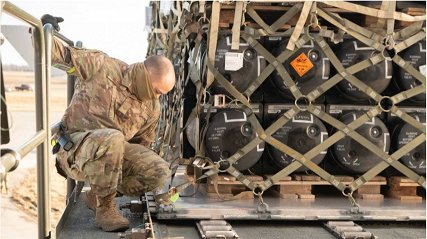Featured Galleries USUBC COLLECTION OF OVER 160 UKRAINE HISTORIC NEWS PHOTOGRAPHS 1918-1997
 Holodomor Posters
Holodomor Posters

SIX WAYS TO HELP UKRAINE SURVIVE RIGHT NOW
 Analysis and Commentary by Philip Breedlove, former Supreme Allied Commander of NATO
Analysis and Commentary by Philip Breedlove, former Supreme Allied Commander of NATO
and Kurt Volker, former U.S. Ambassador to NATO, former U.S. Special Representative for Ukraine
CEPA, Washington, D.C., Thu, Mar 3, 2022
 Ukraine has shown remarkable resolve, resilience, and military capacity as it defends itself against Russia’s unprovoked and massive attacks.
Ukraine has shown remarkable resolve, resilience, and military capacity as it defends itself against Russia’s unprovoked and massive attacks.
By contrast, Russian forces have performed poorly, with failures in planning, execution, and logistics. They have suffered far greater losses of equipment and personnel than expected and have bogged down in what they clearly thought would be a war of a few days.
Despite Ukraine’s early successes, however, there is no guarantee this situation will remain this way. Russia is regrouping its forces and bringing in fresh, additional Russian (and perhaps Belarussian) units. It is massing them around major cities and preparing for major sieges, especially of the capital, Kyiv. Russia is preparing to use missiles, airpower, and shelling to attempt to subdue the city and its defenses. It has already caused over 2,000 civilian deaths, but the upcoming attacks will produce far more.
President Biden has drawn a clear line that the United States will not engage in direct fighting against Russia to help defend Ukraine, but will provide substantial amounts of equipment to help the country defend itself. The total amount committed this year now reaches $1bn.
Even so, US military assistance provided thus far is inadequate to the magnitude of the challenge Ukraine faces. There must be more aid, delivered far more quickly, to help Ukraine survive for the next week. Here are six specific ideas to implement within 24 hours:
- Ensure a full flow of real-time US intelligence information to Ukraine about Russian military capabilities, positions and intentions. Legal arguments that such sharing may implicate the US as a belligerent must be overcome immediately, for example, by fully embedding Ukrainian officers in our intelligence processing so they can report directly, rather than position the United States as “sharing.”
- US assistance already includes Stinger surface-to-air missiles, for low altitude air defense, but should also include systems to give a medium- and high-altitude capability. Ukrainian ground forces can hold their own against Russian ground forces, but we must not allow Russia to gain air superiority over Ukraine.
- Support the transfer by NATO allies of Soviet-made MiG-29 aircraft to Ukraine, with financing as necessary by the European Union. These allies are willing to share the equipment, Ukrainians know how to use it already, and desperately need the additional air capacity.
- Provide US A-10 ground-attack aircraft – currently scheduled to be mothballed – to Ukraine as Excess Defense Articles. Thanks to prior military exchange programs, Ukraine already has a small number of pilots trained to fly the A-10. If spare parts and maintenance are required, use part of the US $1bn funding to allow Ukraine to hire private contractors, rather than involving US personnel directly.
- Work with other NATO Allies to establish a secure corridor to safely and swiftly transport military supplies from Polish territory into Ukraine, for where the Ukrainian military can take possession. There are no Russian forces in this area now, so there would be no hostilities.
- As a humanitarian action, put in place a no-fly zone for protection of the civilian population against Russian aerial bombardment. The exclusion zone should cover Kyiv and western Ukraine — but not extend further east to avoid coming close to Russian borders. The no-fly zone would require clear communication to make clear it serves humanitarian purposes only, and that no US or NATO aircraft or drones would engage in any hostilities against Russian ground forces, except in self-defense if fired upon. Neither would they engage any Russian aircraft provided those aircraft remain outside the declared exclusion zone. Russian air force leaders will understand the lines.
Russia has already launched an unprovoked war of aggression against Ukraine. Frustrated by his initial failures, Vladimir Putin is now about to unleash new, unspeakable atrocities on the people of Ukraine. Yet the Ukrainian people remain determined and prepared to fight for their country.
We must not wait for horrific images of more civilian casualties to flood our television screens before we decide on further action. The people of Ukraine deserve our urgent support — we must act now. Helping Ukraine survive for the next week will give sanctions more time to take a toll on Russia’s military effort, and more time for patriotic and level-headed Russian military, intelligence, and business leaders to comprehend the damage Vladimir Putin is doing to their homeland.
NOTE: Philip Breedlove is retired General of the United States Air Force. He was Supreme Allied Commander of NATO from 2013-2016. During 39 years of service, he was also Commander of US European Command; Commander, US Air Forces Europe, and Air Forces Africa; Vice Chief of Staff of the Air Force; and Assistant Chief of Staff for Air Operations, Plans and Requirements.
Ambassador Kurt Volker is a Distinguished Fellow at the Center for European Policy Analysis. A leading expert in US foreign and national security policy, he served as US Special Representative for Ukraine Negotiations from 2017-2019, and as US Ambassador to NATO from 2008-2009. Kurt Volker is a Senior Advisor to the U.S.-Ukraine Business Council.
PHOTO: Senior Airman Jacob Wilcox, 436th Aerial Port Squadron ramp specialist, loads ammunition, weapons and other equipment bound for Ukraine during a foreign military sales mission at Dover Air Force Base, Delaware, Feb 10, 2022. Since 2014, the United States has committed more than $5.4 billion in total assistance to Ukraine, including security and non-security assistance. The United States reaffirms its steadfast commitment to Ukraine’s sovereignty and territorial integrity in support of a secure and prosperous Ukraine. Credit: Mauricio Campino/U.S. Air Force
LINK: https://cepa.org/six-ways-to-help-ukraine-survive-right-now/











